


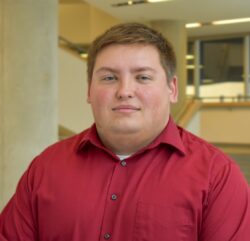 One of the things that graduate architecture student Aaron Comstock loves most about architecture is its ability to impact people. “I feel that too often architecture is only thought of as an aesthetic design field, but it is much more than that,” he said. “If architecture is done right, the building you inhabit has the ability to change how you learn, how a patient is observed by a nurse, how vulnerable you feel in a therapy session, how safe you feel at work, how well you present the most important work of your life. It all happens in a building, designed and, hopefully, designed well, through architecture.”
One of the things that graduate architecture student Aaron Comstock loves most about architecture is its ability to impact people. “I feel that too often architecture is only thought of as an aesthetic design field, but it is much more than that,” he said. “If architecture is done right, the building you inhabit has the ability to change how you learn, how a patient is observed by a nurse, how vulnerable you feel in a therapy session, how safe you feel at work, how well you present the most important work of your life. It all happens in a building, designed and, hopefully, designed well, through architecture.”
Aaron, who is in the second year of his graduate architecture program at the University of Michigan Taubman College of Architecture and Urban Planning, is the 2024 recipient of MAF’s HED Alvin Ernest Harley AIAS Graduate Scholarship. The MAF Scholarship Jury cited Aaron’s very active participation and role as co-President in his AIAS (American Institute of Architecture Students) chapter and strong commitment to community service among the reasons he was selected for the award.
“Winning an MAF scholarship means a lot to me,” said Aaron. “Not only does it help me work towards paying off my degree, but it provides recognition for the hard work I have been doing. Receiving this scholarship places me among a group of astounding architecture students and allows me to network with highly accomplished architects across the state.”
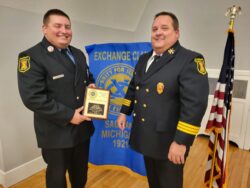 He continues, “Everyone associated with the scholarship has used or is in the process of using architecture to change the world, just as Alvin Ernest Harley did. Through his firm, which still stands tall after 116 years, he was able to use architecture to improve the Michigan region. Being recognized in honor of him means the world to me and only pushes me to continue my work in the field of architecture.”
He continues, “Everyone associated with the scholarship has used or is in the process of using architecture to change the world, just as Alvin Ernest Harley did. Through his firm, which still stands tall after 116 years, he was able to use architecture to improve the Michigan region. Being recognized in honor of him means the world to me and only pushes me to continue my work in the field of architecture.”
As a child, Aaron enjoyed playing with Legos, Tonka trucks, Lincoln Logs, and anything that let him design and shape the world around him. “I took a drafting class in eighth-grade, and began drafting and designing elevations in my free time, looking at floor plans whenever my dad had them for work (as a public works department manager),” he said.
“After four years of high school architecture classes, I knew architecture was the place for me.”
Currently in the last year of his Master of Architecture program at UM Taubman, Aaron notes that he enjoys the program because of the people and teaching style. “Every professor teaches a different way of design and allows you to tailor the style to your interests,” he said. “As a firefighter, I wanted to take my experience from my Health by Design course and use it to study the wellness and architecture of fire stations. Taubman doesn’t offer that course but I was able to make it an independent study and work with one of the leading designers on the forefront of Health by Design to accomplish the research. Taubman also has such a friendly and supportive culture there where students are pushed to connect and appreciate one other’s differences. We all have different experiences and ideas, and the culmination of all of them in a productive space is something special.”
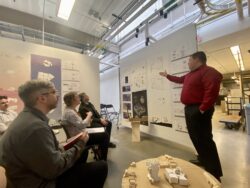 Post-graduation, Aaron notes he would prefer to design architecture that engages the public and positively impacts them. “Whether it be a church, a community center, a hospital, a school, or public safety building, I want my work to build and strengthen the community through shelter and the built environment. By utilizing strategies like Health by Design and community input, I think architecture can serve this purpose.”
Post-graduation, Aaron notes he would prefer to design architecture that engages the public and positively impacts them. “Whether it be a church, a community center, a hospital, a school, or public safety building, I want my work to build and strengthen the community through shelter and the built environment. By utilizing strategies like Health by Design and community input, I think architecture can serve this purpose.”
As part of their MAF scholarship application, students must include a personal statement describing their interest, experience and plans related to architecture, as well as information on your leadership and extracurricular activities. “I spoke about my experience working as a peer mentor to fellow students, an orientation leader, a firefighter/EMT, and a co-founder/co-president of the University of Michigan AIAS Chapter,” said Aaron. “In all of these aspects, I am privileged to work with others and give back to the community. Whether it be helping a mentee not stress about a final presentation, directing a new student where to get help with finances, or responding to emergency situations, I am able to use my experiences and leadership skills to make a positive impact. I plan to continue this both in the field of architecture by hopefully owning my own practice that lives up to that expectation, and outside in whatever ways I can to give back to others.”
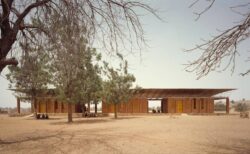
Students must also in a personal portfolio with their application. Aaron included professional work from his time at an architecture firm and at an engineering firm; a park building he designed for his hometown; and personal artwork. He also included a selection of his school projects, including a residential structure based on the essence of Casa Poli, a nature center, a funerary complex based on the Bali fire rituals, a wooden bridge, and a wooden tower designed to test structural capabilities.
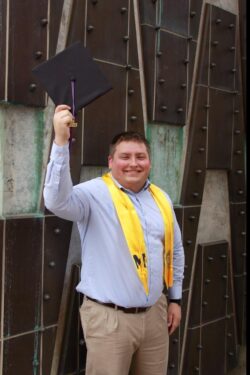 MAF’s mission is to advance awareness of how architecture enriches life. How does Aaron think architecture enriches life? “As previously mentioned, I think architecture can completely change how we experience space and live our lives,” he said. “With well-designed architecture, people’s attitudes can be changed, their perceptions of themselves and the world they live in can be improved, and better health can be obtained. Architecture plays a much greater role in people’s lives than it is given credit for, and has played roles in everything from the worst atrocities to how quickly people can recover in hospitals.”
MAF’s mission is to advance awareness of how architecture enriches life. How does Aaron think architecture enriches life? “As previously mentioned, I think architecture can completely change how we experience space and live our lives,” he said. “With well-designed architecture, people’s attitudes can be changed, their perceptions of themselves and the world they live in can be improved, and better health can be obtained. Architecture plays a much greater role in people’s lives than it is given credit for, and has played roles in everything from the worst atrocities to how quickly people can recover in hospitals.”
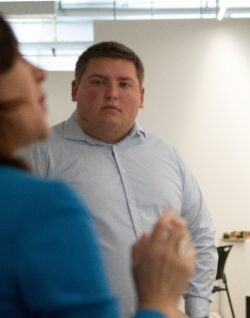 Aaron adds, “Architecture is the way we study and shape the world around us to enrich life in every aspect. When the right designers with the right intentions are given these tools, they can undoubtedly change the world around them.”
Aaron adds, “Architecture is the way we study and shape the world around us to enrich life in every aspect. When the right designers with the right intentions are given these tools, they can undoubtedly change the world around them.”
“Schools can be designed safer and made to improve collaboration. Hospitals can be improved to handle the new health concerns of today, and community centers can be established to bring communities to the forefront and improve life for visitors and residents alike.”
Top to bottom: a selection of photos of Aaron, and center, his favorite work of architecture, the Gando Primary School by Francis Kere.
“This was a project Kere did in graduate school to develop a better, closer primary school for his hometown,: said Aaron. “The school not only served as a primary school to offer students a chance at a true education, but every portion of the project gave back to the community. The building also served as a trade school where Kere taught local community members skills to build the structure they could use afterward. Kere didn’t attempt to bring in external materials or workforce, but rather, used the project to boost his community in every aspect.”
(Gando Primary School, photo by Simeon Duchoud, as pictured on the Kere Architecture website, https://www.kerearchitecture.com/work/building/gando-primary-school-3)